
Rosie Fodera |
|
Speedlite Issue
|
|
|
|
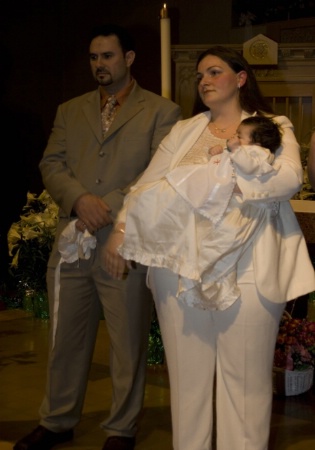
Sample Shot
Rosie Fodera
|
|
|
|
I have been using a Canon Speedlite and have not been getting nice results. I shot in P Mode, flash on ETTL. My shots are either coming out over exposed or under exposed and I'm getting shadows. Why am I getting shadows when the wall is far away from the subject. Attached is an example for review.
Rosie
May 04, 2007
|
|
|
Jerry Frazier |
|
It looks like you metered on the white. Put your camera in manual mode, and set the aperture and shutter speed so that they are just below the middle of where the meter says it should be for the exposure you need. Set your flash on ETTL and see what happens. You shoud get a nice balanced image this way. Sorry, I don't know how else to answer your question, but shooting in program mode with flash will always produce pretty crappy results. Program mode is usually OK, with Canons, in natural lighting, though.
May 04, 2007
|
|
|
Jerry Frazier |
|
Also, you're getting shadows because your primary light is flash, and it's throwing a ton of light on the subjects. Once you balance the lighting in camera, with the way I suggested, you will no longer see shadows.
May 04, 2007
|
|
|
Rosie Fodera |
|
Thanks for your response. So do you suggest always shooting in Manual Mode when using a speedlite? I thought that the speedlite would take more time to recharge in Manual Mode, therefore making it hard to take quick consecutive shots.
May 04, 2007
|
|
|
Rosie Fodera |
|
Sorry, another question..When I set my camera to manual I would want to set my shutter speed to 200 or so so I don't get a blurry image correct? Do I even have to worry about shutter speed with the flash?
May 04, 2007
|
|
|
Jon Close |
|
The light from the flash cannot evenly light an entire room, near and far subjects. The camera meters and directs the flash to give enough light to expose your near subject, the woman in white. This it did pretty well. It could have given a little more light to her, but the E-TTL metering algorithms work very hard to not blow out white/bright highlights. You might try setting FEC (flash exposure compensation) on the speedlight (or the camera if it has FEC control) to +2/3. The light falls off quickly with distance from the flash, so the other subject behind the woman is not so well lit. My guess is there is also spotlighting near the alter and he is standing outside it while the woman is in it. On EOS cameras, P mode with flash fixes the shutter speed at 1/60 or faster. With the ISO set and a probable maximum aperture of f/5.6 on your lens, you cannot get good exposure to the dimly lit background. Try setting a higher ISO, using a lens with wider maximum aperture.
May 04, 2007
|
|
|
Rosie Fodera |
|
Thanks for the tips. Unfortunately, I don't have any other lens and can't afford a new one at this time...Therefore, would you suggest shooting in Manual mode like Jerry suggested?
May 04, 2007
|
|
|
Rosie Fodera |
|
|
|
|
|
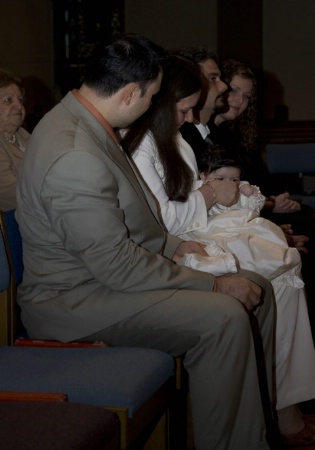
Example 2
Rosie Fodera
|
|
|
|
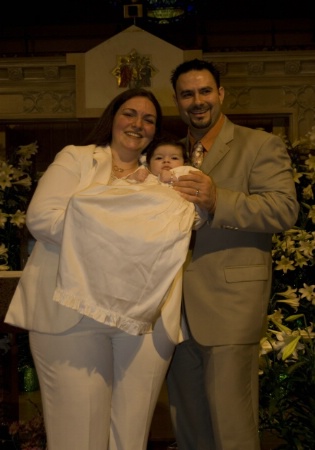
Example 3
Rosie Fodera
|
|
|
|
Here is another example of my terrible shots :-.Example 2: Shot in P mode, the flash fired, ISO 200, shutter 1/60 Fstop 5.0. Help.....
Also my other shots came out with redish tint??- Example 3 (same settings)
May 04, 2007
|
|
|
Rosie Fodera |
|
|
|
|
|
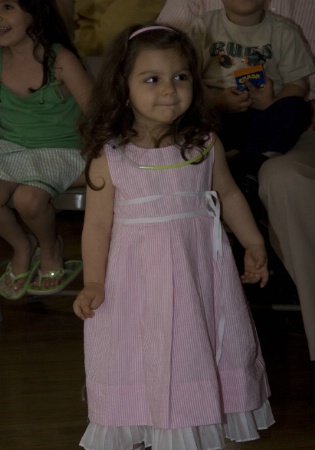
Mia
Rosie Fodera
|
|
|
|
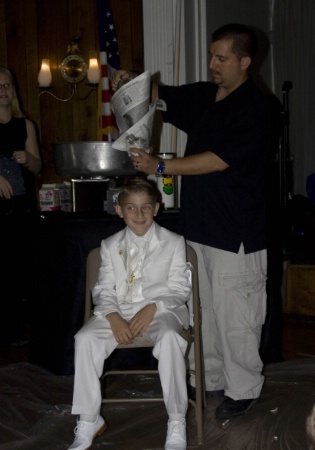 Rosie Fodera
|
|
|
|
Hope you guys can help again.....I took your advice shot in Manual Mode, increased ISO to 400 shutter speed at 200 Ap F8. Still didn't get great results. Can anyone shed some light, I must be doing something wrong!
May 22, 2007
|
|
|
Jerry Frazier |
|
Don't worry about your shutter speed so much. You can easily go to 1/60 sec. I often will go to 1/30. The flash freezes the motion, so it's not a big deal. Take you shutter speed way down. The problem I see is you need to balance the ambient light (room lighting) with the flash, so that the flash doesn't need to do too much work. Then your shots will look great because they will be using the room light, mostly, with a small amount of flash on the subjects. So, crank the ISO up to 800 or 1600, bring your shutter speed down (don't be scared, it will be OK). Make your aperture as large as you can (small number). Lastly, the biggest mistake you are making is directing the flash at the subjects. Never do that. Point your flash straight up in the air. Don't worry. Trust me. Report back.
May 23, 2007
|
|
|
Suzanne Colson |
|
I too have struggled with flash. Check out the following link... Some great information on using flash: http://www.planetneil.com./faq/flash-techniques.html
May 23, 2007
|
|
|
Rosie Fodera |
|
thank you both. I will try your suggestions, but my only concern is that if I increase my ISO to 800 I will get grainy shots. In addition, I thought that you should point your flash to the subject if the cieling is too high for it to bounce off of. Which in this case they had very high cielings (12-13ft.). Another question, my batteries only lasted 3 hours! Is that normal? Thanks for the site, I'm going to read now...
May 23, 2007
|
|
|
Jerry Frazier |
|
Neil is a great guy and a master craftsman with flash. It shouldn't get grainy shots at ISO 800. But, if you do, so what? Everything is a trade off. I shoot at ISO 6400 if that's what I have to do to get the shot. Grain rocks! Just call it art, and you're good to go :) High ceiling schmieling. Point it up. 3 hours isn't normal. But, you were probably blasting full power. Since I use a small amount of flash; a kiss of light, my batteries last a good while.
May 23, 2007
|
|
|
Raymond H. Kemp |
|
Boy, you should really not have to push the ISO up to 800 or beyond if you are balancing the flash with the ambient light. I shoot all the time in extremely dark conditions and get great results balancing my flash with whatever ambient light there is on the scene. As Jerry pointed out you can drop your shutter speed to 1/60th or even 1/30th and get great balanced results. For my night accident scenes, I shoot at ISO 400 and 1/30th. I use a Nikon SB-800 speed light set to TTL-BL (balanced). If you look on my gallery at the night image “Morning Rescue” that was taken with very little light on the side of the wreck where I was standing. As you can see it lighted very well and pulled in the ambient light from the rescue trucks parked up on the highway. Jerry has brought up some great points, but from what I see you should have all kinds of detail in your images. Carefully check your camera settings and make sure your camera and flash EV settings aren’t turned back into the negative range. Become fully familiar with all of your flash settings and how they function. If something is not set correctly it will impact your image. Also, how far are you from the subjects in your images and what kind of lens are you using? Good luck and let us know your results! Ray
May 23, 2007
|
|
|
Neil Van Niekerk |
|
Hi there Rosie .. You're battling several things here at the same time - all conspiring to give a problematic situation and photos. Firstly, your lens is slow. f5.6 maximum aperture limits the range of your flash, and limits what you can set as accompanying shutter speed or ISO. The shadows to the side are there because of holding the camera sideways and shooting with direct flash.
The two ways around this is to either bounce flash (which might not be feasible in a venue as large as that), or using a flash bracket, (which is a mission.) That the background goes darker is caused by light fall-off from your strobe, and the ambient light being less there anyway. The way to get around this is to bounce flash, to help lessen the effect of light fall-off to the back. (And again, this might not be feasible in a large venue.) Program mode - this is a major obstacle in getting the best results with flash. I'd really suggest getting to grips with the manual exposure mode on your camera. It is the *only* way to begin understanding exposure metering and light. As long as you leave the decision making to the camera, you're less likely to understand the basis of exposure metering and light. There is a huge discrepencay between the white balance of the flash, and the white balance of the tungsten light. Two ways around this:
1. use a LOT of flash and overpower the available light, so that the yellow cast is reduced.
2. gel your flash.
(More on this here on my one webpage:
http://www.planetneil.com/faq/flash-with-tungsten.html
I'm not au faith with your camera, but most Canon D-SLRs allow you to set how the flash metering works - average, or evaulative. I would suspect that in this case, it was at evalautive flash metering, which will also work in reducing the power of the TTL flash (especially with the large area of white dress there in the first photo.)
As for specific shutter speed / aperture / ISO combinations .. this is tough to recommend specific settings, since the lighting scenarios vary a lot, and we'd actually have to *be* there to give specific advice on settings. Personally, I would start at 800 ISO in this situation. High ISO is a problem at times .. but you also have to decide how large you're going to use these images. If they won't be printed larger than 4x6, then high-iso noise will appear to be less of a problem than bigger enlargements. One thing to consider here with respect to using a higher iso vs lower iso ... it is much easier to fix the appearance of high-iso noise, than it is to fix a photos spoilt by camera shake or subject movement. So if I have the choice to make, I'd rather go for a higher ISO and accompanying higher shutter speed. Dragging the shutter (as you asked about in your email to me) would help bring ambient light in .. but this brings in two other problems ...
1. WB mismatches between flash and tungsten.
(but look at the other webpage again(
2. slower shutter speed can cause camera shake / subject movement.
So in all this, it is a (sometimes delicate) balance between your settings, to achieve the desired results ... while accepting the compromises forced on us by a specific shooting scenario.
I hope this helps. thanks Neil. PS .. hey there Jerry. :)
May 25, 2007
|
|
|
Mike Rubin |
|
Rosie, Check out this link http://photonotes.org/articles/eos-flash/ It is a 3 part PDF file which is highly detailed on how EOS flash works. It is a great reference and worth taking the time to read.
May 25, 2007
|
|
|
Rosie Fodera |
|
|
|
|
|
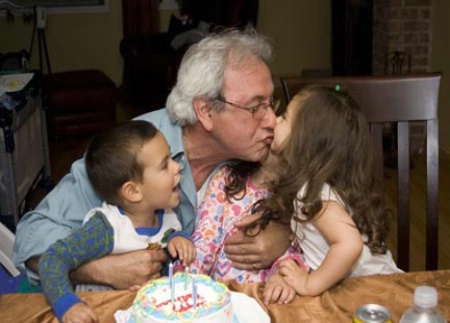
Speedlite test
Rosie Fodera
|
|
|
|
Just want to thank you guys for all of your help. I'm reporting back. Used my speedlite, ISO200 shutter speed 1/25 Aperture F4.5 pointed the flash to the cieling and was much happier with my results! Next test will be to test this same set up in a different environment. I was pretty close them when taking the pic. I did get shadows when I took the picture vertically. Thanks for your help!
June 13, 2007
|
|
|
Jerry Frazier |
|
What a difference. Glad we could help. Happy shooting.
June 14, 2007
|
|
|
|
Log in to respond or ask your own question.
|